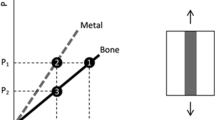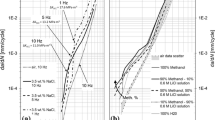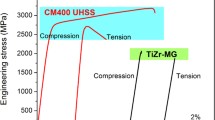Abstract
It is well known that metallic materials exhibit worse fatigue damage tolerance as they behave stronger in strength and softer in modulus. This raises concern on the long term safety of the recently developed biomechanical compatible titanium alloys with high strength and low modulus. Here we demonstrate via a model alloy, Ti-24Nb-4Zr-8Sn in weight percent, that this group of multifunctional titanium alloys possessing nonlinear elastic deformation behavior is tolerant in fatigue notch damage. The results reveal that the alloy has a high strength-to-modulus (σ/E) ratio reaching 2% but its fatigue notch sensitivity (q) is low, which decreases linearly from 0.45 to 0.25 as stress concentration factor increases from 2 to 4. This exceeds significantly the typical relationship between σ/E and q of other metallic materials exhibiting linear elasticity. Furthermore, fatigue damage is characterized by an extremely deflected mountain-shape fracture surface, resulting in much longer and more tortuous crack growth path as compared to these linear elastic materials. The above phenomena can be explained by the nonlinear elasticity and its induced stress relief at the notch root in an adaptive manner of higher stress stronger relief. This finding provides a new strategy to balance high strength and good damage tolerance property of metallic materials.
摘要
金属材料的抗损伤容限能力一般随着强度的提高及模量的降低而显著弱化. 对于高强度低模量医用钛合金, 这可能引发长期使用安全性的担忧. 本文以Ti-24Nb-4Zr-8Sn合金为模型材料研究了缺口疲劳行为, 结果表明: 非线性弹性合金具有优异的抗疲劳缺口损伤能力, 其强度与模量的比值高达2%时仍然具有较弱的疲劳缺口敏感性, 两者关系远优于常规线弹性金属材料, 如不锈钢、 钛合金、 铝合金和镁合金等; 该合金的疲劳断口呈现极度偏折的山峰状形貌, 显著抑制了裂纹的萌生与扩展. 依据非线性弹性变形理论, 本文给出了一种抑制缺口疲劳损伤的自适应机制: 非线性弹性有效缓解了缺口根部的应力集中, 并且这种效果随着应力的提高而显著增强. 因此, 非线性弹性变形行为是一种实现高强度金属材料耐疲劳损伤的重要手段.
Similar content being viewed by others
References
Brunette DM, Tengvall P, Textor M, et al. Titanium in Medicine. Berlin: Springer, 2001
Long M, Rack HJ. Titanium alloys in total joint replacement—a materials science perspective. Biomaterials, 1998, 19: 1621–1639
Li S, Li X, Hou W, et al. Fabrication of open-cellular (porous) titanium alloy implants: osseointegration, vascularization and preliminary human trials. Sci China Mater, 2018, 61: 525–536
Saito T, Furuta T, Hwang JH, et al. Multifunctional alloys obtained via a dislocation-free plastic deformation mechanism. Science, 2003, 300: 464–467
Geetha M, Singh AK, Asokamani R, et al. Ti based biomaterials, the ultimate choice for orthopaedic implants—a review. Prog Mater Sci, 2009, 54: 397–425
Niinomi M. Recent metallic materials for biomedical applications. Metall Mat Trans A, 2002, 33: 477–486
Hao YL, Li SJ, Sun SY, et al. Super-elastic titanium alloy with unstable plastic deformation. Appl Phys Lett, 2005, 87: 091906
Hao YL, Li SJ, Sun BB, et al. Ductile titanium alloy with low poisson’s ratio. Phys Rev Lett, 2007, 98: 216405
Guo Z, Fu J, Zhang YQ, et al. Early effect of Ti-24Nb-4Zr-7.9Sn intramedullary nails on fractured bone. Mater Sci Eng-C, 2009, 29: 963–968
Nune KC, Misra RDK, Li SJ, et al. Cellular response of osteoblasts to low modulus Ti-24Nb-4Zr-8Sn alloy mesh structure. J Biomed Mater Res, 2017, 105: 859–870
Nune KC, Misra RDK, Li SJ, et al. Osteoblast cellular activity on low elastic modulus Ti-24Nb-4Zr-8Sn alloy. Dental Mater, 2017, 33: 152–165
Zhang SQ, Li SJ, Jia MT, et al. Fatigue properties of a multifunctional titanium alloy exhibiting nonlinear elastic deformation behavior. Scr Mater, 2009, 60: 733–736
Zhang SQ, Li SJ, Jia MT, et al. Low-cycle fatigue properties of a titanium alloy exhibiting nonlinear elastic deformation behavior. Acta Mater, 2011, 59: 4690–4699
Chapetti M, Katsura N, Tagawa T, et al. Static strengthening and fatigue blunt-notch sensitivity in low-carbon steels. Int J Fatigue, 2001, 23: 207–214
Xue P, Huang Z, Wang B, et al. Intrinsic high cycle fatigue behavior of ultrafine grained pure Cu with stable structure. Sci China Mater, 2016, 59: 531–537
Cui L, Sun L, Zeng R, et al. In vitro degradation and biocompatibility of Mg-Li-Ca alloys—the influence of Li content. Sci China Mater, 2018, 61: 607–618
Lu K, Lu L, Suresh S. Strengthening materials by engineering coherent internal boundaries at the nanoscale. Science, 2009, 324: 349–352
Ritchie RO. Mechanisms of fatigue-crack propagation in ductile and brittle solids. Int J Fract, 1999, 100: 55–83
Wang HL. Continuous solid-state phase transformation in Ti2448 alloy over wide temperature range. Dissertation for Doctoral Degree. Shenyang: Institute of Metal Research, Chinese Academy of Sciences, 2016
Hao YL, Wang HL, Li T, et al. Superelasticity and tunable thermal expansion across a wide temperature range. J Mater Sci Tech, 2016, 32: 705–709
Wang HL, Hao YL, He SY, et al. Elastically confined martensitic transformation at the nano-scale in a multifunctional titanium alloy. Acta Mater, 2017, 135: 330–339
Wang HL, Hao YL, He SY, et al. Tracing the coupled atomic shear and shuffle for a cubic to a hexagonal crystal transition. Scr Mater, 2017, 133: 70–74
Wang HL, Shah SAA, Hao YL, et al. Stabilizing the body centered cubic crystal in titanium alloys by a nano-scale concentration modulation. J Alloys Compd, 2017, 700: 155–158
Hao YL, Li SJ, Sun SY, et al. Elastic deformation behaviour of Ti-24Nb-4Zr-7.9Sn for biomedical applications. Acta Biomater, 2007, 3: 277–286
Pilkey WD, Pilkey DF. Peterson’s Stress Concentration Factors. Hoboken: Wiley, 2008
Li SJ, Cui TC, Hao YL, et al. Fatigue properties of a metastable β-type titanium alloy with reversible phase transformation. Acta Biomater, 2008, 4: 305–317
Lanning D, Nicholas T, Haritos GK. On the use of critical distance theories for the prediction of the high cycle fatigue limit stress in notched Ti-6Al-4V. Int J Fatigue, 2005, 27: 45–57
Nalla RK, Boyce BL, Campbell JP, et al. Influence of microstructure on high-cycle fatigue of Ti-6Al-4V: bimodal vs. lamellar structures. Metall Mat Trans A, 2002, 33: 899–918
Haritos G, Nicholas T, Lanning DB. Notch size effects in HCF behavior of Ti-6Al-4V. Int J Fatigue, 1999, 21: 643–652
Liu WC, Dong J, Zhang P, et al. Smooth and notched fatigue performance of aging treated and shot peened ZK60 magnesium alloy. J Mater Res, 2010, 25: 1375–1387
Bian JC, Tokaji K, Ogawa T. Notch sensitivity of aluminum-lithium alloys in fatigue. Fat Frac Eng Mat Struct, 1995, 18: 119–127
Tokaji K. Notch fatigue behaviour in a Sb-modified permanentmold cast A356-T6 aluminium alloy. Mater Sci Eng-A, 2005, 396: 333–340
Benedetti M, Fontanari V, Santus C, et al. Notch fatigue behaviour of shot peened high-strength aluminium alloys: experiments and predictions using a critical distance method. Int J Fatigue, 2010, 32: 1600–1611
Kim WJ, Hyun CY, Kim HK. Fatigue strength of ultrafine-grained pure Ti after severe plastic deformation. Scr Mater, 2006, 54: 1745–1750
Yuri T, Ono Y, Ogata T. Effects of surface roughness and notch on fatigue properties for Ti-5Al-2.5Sn ELI alloy at cryogenic temperatures. Sci Tech Adv Mater, 2003, 4: 291–299
Yue T, Tabeshfar K, Forsyth PJE. Effect of microstructure on the plain and notched fatigue properties of IMI 550 Ti alloy. Int J Fatigue, 1985, 7: 149–153
Baragetti S, Lusvarghi L, Pighetti Mantini F, et al. Fatigue behaviour of notched PVD-coated titanium components. Key Eng Mater, 2007, 348–349: 313–316
Akahori T, Niinomi M, Otani M, et al. Notch fatigue properties of a Ti-29Nb-13Ta-4.6Zr alloy for biomedical applications. J Jpn Inst Light Met, 2005, 55: 575–581
Khan MK, Liu YJ, Wang QY, et al. Effect of small scale notches on the very high cycle fatigue of AISI 310 stainless steel. Fatigue Fract Eng Mater Struct, 2015, 38: 290–299
Akita M, Tokaji K. Effect of carburizing on notch fatigue behaviour in AISI 316 austenitic stainless steel. Surf Coatings Tech, 2006, 200: 6073–6078
Chapetti MD, Miyata H, Tagawa T, et al. Fatigue strength of ultrafine grained steels. Mater Sci Eng-A, 2004, 381: 331–336
Hui W, Zhang Y, Zhao X, et al. High cycle fatigue behavior of Vmicroalloyed medium carbon steels: a comparison between bainitic and ferritic-pearlitic microstructures. Int J Fatigue, 2016, 91: 232–241
Suresh S. Crack deflection: implications for the growth of long and short fatigue cracks. Metall Mater Trans A, 1983, 14: 2375–2385
Suresh S. Fatigue crack deflection and fracture surface contact: micromechanical models. Metall Mater Trans A, 1985, 16: 249–260
Rajagopal KR. On implicit constitutive theories. Appl Math, 2003, 48: 279–319
Rajagopal KR. The elasticity of elasticity. Zeit Angew Math Phys, 2007, 58: 309–317
Rajagopal KR. On the nonlinear elastic response of bodies in the small strain range. Acta Mech, 2014, 225: 1545–1553
Devendiran VK, Sandeep RK, Kannan K, et al. A thermodynamically consistent constitutive equation for describing the response exhibited by several alloys and the study of a meaningful physical problem. Int J Solids Struct, 2017, 108: 1–10
Acknowledgements
This work was supported by the National Key Research and Development Program of China (2016YFC1102601 and 2017YFC1104901), the National Natural Science Foundation of China (51571190 and 51631007), and the Key Research Program of Frontier Sciences of Chinese Academy of Sciences (QYZDJ-SSW-JSC031).
Author information
Authors and Affiliations
Corresponding author
Additional information
Jinrui Zhang received his BE degree from the University of Science and Technology Beijing in 2013 and is now a PhD student at the Institute of Metal Research, Chinese Academy of Sciences. His research interests include the damage tolerance of biomedical titanium alloy.
Yulin Hao is a professor at the Institute of Metal Research, Chinese Academy of Sciences. He received his PhD degree from the Institute of Metal Research, Chinese Academy of Sciences, in 1999. His research interests include the biomedical titanium alloys and their additive manufacturing.
Rights and permissions
About this article
Cite this article
Zhang, J., Shah, S.A.A., Hao, Y. et al. Weak fatigue notch sensitivity in a biomedical titanium alloy exhibiting nonlinear elasticity. Sci. China Mater. 61, 537–544 (2018). https://doi.org/10.1007/s40843-017-9158-7
Received:
Accepted:
Published:
Issue Date:
DOI: https://doi.org/10.1007/s40843-017-9158-7




